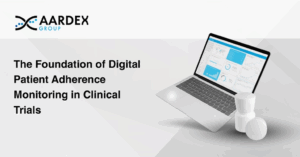The emergence of outcome-based contracts in clinical research has placed an additional consideration on the already thorny issue of adherence. When drug companies are paid according to the real-world effectiveness of their products, ensuring people take the medications as prescribed is essential to the all-important return on investment (ROI).
Modern approaches, such as digital adherence monitoring, have the potential to bridge this gap – but only if they are patient-centric and implemented in a way that values transparency and enables individualised support.
The Rise of Outcome-Based Contracts1
In recent years, payers have found it challenging to provide access to expensive, innovative new drugs, while still using their limited resources wisely.
This has spawned the emergence of outcome-based contracts, which seek to align payments with real-world benefits rather than those recorded in heavily controlled clinical trials. Agreements may entail the manufacturer wholly or partially refunding the payer if a pre-specified threshold, whether that be cure, or a reduction in mortality or morbidity, is not met.
Such contracts are usually subject to high levels of confidentiality, but it is thought that the first were agreed in the United States in the mid-1990s. In 2002, the UK followed suit, introducing the Risk Sharing Scheme in a bid to ensure people with multiple sclerosis would be able to access a new generation of disease modifying therapies (DMTs).
Under the programme, which covered four DMTs, patients were monitored via a clinical disability score, and the drugs’ prices retrospectively adjusted to meet a cost per quality adjusted life year (QALY) of £36,000 or less. More recently, NHS England implemented a “pay per cure” contract cutting edge new hepatitis C drugs, in which the manufacturer is only paid if the patient achieves a sustained viral response (SVR).
It stands to reason, then, that this model places an additional importance on medication adherence.
Nothing stops a drug working like not taking it, and in outcomes-based contracts, a lack of efficacy will significancy affect ROI. There is some evidence to suggest this correlation is already being recognised in payer/manufacturer agreements. One US contract, for example, granted additional discounts if administrative data showed people with diabetes had adhered to their prescriptions.
However, as noted in an analysis piece published in the BMJ in March, such contracts are usually confidential, making it difficult to determine how or how often adherence is tied to payment. Indeed, in the diabetes example outlined above, the specific stipulations were not disclosed
Modern Adherence Monitoring Challenges
This matters because poor adherence to medication is a well-documented, wide-spread problem, affecting up to 50% of people who are prescribed medications to manage chronic conditions such as diabetes or hypertension.2
The reasons are as individual as they are complex, though they fit broadly into two categories. Intentional non-adherence is deliberate, and largely associated with motivation to take the medicines – a person may not believe the medicine is working, for example, or they may experience side effects. Unintentional non-adherence is driven by a lack of capacity or resources to take the medications, such as not being able to afford to fill a prescription or forgetting to take the dose.3
Despite the obvious consequences, not least the US’ annual 125,000 avoidable deaths and $100 billion in preventable healthcare costs,2 the problem has remained “unsolved” for decades.
Historically, healthcare teams have relied on subjective, sometimes invasive, measures that are open to bias. Counting returned pills, working from HCP or self-report data, or monitoring drug levels blood, urine, or hair, for example, only provide a summary of adherence between visits.
Modern solutions, which include elements like text message reminders, smart pills, connected packaging, and video checks, are now starting to become more mainstream. To utilize them effectively, we must ensure they are fit for purpose and do not compound the problems we already face.
The BMJ analysis piece highlighted that, without careful implementation, modern forms of monitoring could reduce patient autonomy and damage the all-important HCP/patient relationship, for instance.
“Expectations to use adherence monitoring could undermine voluntariness or even become coercive if, for example, a patient is concerned that non-use will harm the relationship with their physician,” wrote the authors, adding that combining outcomes-based contracts with adherence monitoring, was likely to have “unpredictable consequences”.
“Physicians, for example, may exert implicit or explicit pressure on patients to use adherence monitoring to gain insights into how they take their medications. Behaviours may also be influenced by the amount of public information available for each contract, including knowledge of the potential financial implications of non-adherence.”
In addition, some solutions, such as video check, serve to increase patient burden, which is associated with poor adherence. Others, such as those that collect one-dimensional data, will fail to provide the nuanced view of the multilevel, multidimensional nature of non-adherence needed to demonstrate efficacy.
Patient-Centric Approach
Bridging the gap between medication adherence and outcomes requires a patient-centric approach that provides a holistic view of medicine taking behavior and enables individualised interventions to the benefit of the patient; i.e. maximizing benefits and minimizing harm.
One such form of digital adherence monitoring combines the powers of connected packaging and sophisticated data analytics to reinforce, rather than damage, the patient/HCP partnership.
Connected pre-filled syringes or blister packs, for example, detect when the injection was administered or the tablet removed from the packet, and transmit that information to a cloud-based platform. The platform then analyses the data before creating visualisations and focused feedback for clinical teams and patients alike.
This model, which asks patients to do nothing more than take their medicine, is frictionless and non-invasive, meaning it creates no additional barriers to adherence.
Crucially, it is holistic and patient centred. The connected packaging collects real time data, and the algorithms spot missed doses or erratic dosing patterns. This allows HCPs to identify those at risk, and work with them to prepare and deliver individualised, interventions.
What’s more, it is effective. Studies have shown that connected package monitoring is 97% accurate, compared to 60% accurate for pill count, 50% for healthcare professional rating, and just 27% for self-report.4
Transparency
According to the BMJ analysis article, both adherence monitoring technologies and the contracts they are meant to support will fail if they are not created in partnership with patients.
Of course, adopting the right technology is only part of the solution. We also need to build trust in the process, by providing transparency around the details of outcome-based contacts, around the use adherence monitoring, and around its intentions.
But with outcome-based contracts only expected to become more ubiquitous in the coming years, it is clear that now is the time to grasp the nettle.
References
- Bartholomew, T., Naci, H., Robertson, E., & Schmidt, H. (2022). Use of adherence monitoring in drug contracts tied to outcomes: put patients first. BMJ, 376.
- Kleinsinger, F. (2018). The unmet challenge of medication nonadherence. The Permanente Journal, 22.
- Molloy, G. J., Messerli-Bürgy, N., Hutton, G., Wikman, A., Perkins-Porras, L., & Steptoe, A. (2014). Intentional and unintentional non-adherence to medications following an acute coronary syndrome: a longitudinal study. Journal of psychosomatic research, 76(5), 430-432.
- El Alili, M., Vrijens, B., Demonceau, J., Evers, S. M., & Hiligsmann, M. (2016). A scoping review of studies comparing the medication event monitoring system (MEMS) with alternative methods for measuring medication adherence. British journal of clinical pharmacology, 82(1), 268-279.



